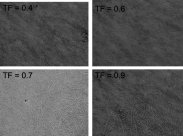An assessment of the ocular tear film in patients with thyroid disorders
- PMID: 31388294
- PMCID: PMC6607206
- DOI: 10.2147/OPTH.S210044
An assessment of the ocular tear film in patients with thyroid disorders
Abstract
Objective: To investigate the ocular tear film in patients with thyroid disorders using various tests. Methods: The study involved the assessment of the ocular tear film in 20 patients with thyroid disorders (6 men and 14 women) aged 18-43 years (mean±standard deviation=34.3±3.2 years). An age-matched control group consisting of 20 subjects (8 males and 12 females) ranging in age from 18 to 43 years (31.3±2.9 years) was also examined under similar conditions. All patients completed the Ocular Surface Disease Index questionnaire, followed by the tear ferning test within the right eye. A phenol red thread test was carried out 10 mins later followed by the fluorescein tear break-up test with a 10-min gap between the tests being implemented. Results: The median score for the Ocular Surface Disease Index (P<0.05) showed the condition of mild dry eyes [median (IQR)=15.5 (21.9)] in patients with thyroid disorders compared to the control group [5.6 (3.6)]. The mean score for the phenol red thread test within both the right and left eyes showed acceptable tear volumes of 11.7±8.1 and 10.5±7.4 mm, respectively, but this was much lower (P<0.05) compared to those recorded within the control group (22.2±6.5 and 20.7±5.2 mm, respectively). In addition, the mean for the tear break-up time (P<0.05) scores in both eyes within the patients with thyroid disorders revealed a certain degree of eye dryness (4.9±1.6 and 4.2±1.9 s), while the control group showed normal eye scores (13.2±2.6 and 12.3±2.2 s). The median score for tear ferning grades showed eye dryness [2.0 (2.2)] within the study group and normal eyes [1.2 (0.9)] within the control group. Conclusions: Patients with thyroid disorders have a significant level of eye dryness compared to normal eye subjects.
Keywords: dry eye; ocular tear film; phenol red thread test; tear break-up time test; tear ferning patterns; thyroid gland disorders.
Conflict of interest statement
The authors report no conflicts of interest in this work.
Figures





References
-
- Lemp MA. Report of the National Eye Institute/Industry workshop on clinical trials in dry eyes. Clao J. 1995;21(4):221–232. - PubMed
LinkOut - more resources
Full Text Sources
Miscellaneous

